Chapter 3- Pests, Predators and Diseases of Honeybees: Prevention and Control
3.1 Introduction
As apiculture is capturing global attention the bee farmers many times get disheartened when pests and diseases wipe out bee populations en masse and ruin their patient efforts. Awareness on honeybee pathology is therefore very important to achieve sustained progress in honey production. This is a serious issue as India is reported to have the highest number of bee colonies in the world, but ranks only seventh in honey production. Here we discuss the problems in brief and recommend measures for mitigation of these maladies. Poor management practices in beekeeping weaken the bee colony increasing its susceptibility to pests and predators. The worker honeybees, which constitute bulk of the population, though are armed individually with a sting and poison and collectively strike fear on most of their marauders which attack the colony, themselves need assistance sometimes from beekeeper to defend against pests and diseases. Enemies of honeybees are those animals, which cause disturbances and nuisance in functioning of the colony and range widely in size from microscopic mites to large mammals such as bears (Gulati and Kaushik, 2004). The stings are, nevertheless, ineffective against the tiny mites or fungal, bacterial and viral diseases. The maladies of the bee colonies are divided into three categories like diseases (viruses, bacteria, and fungi), pest infestation (mite and protozoan) and natural enemies (mammals, birds, reptiles, beetles, ants and wasps). Of these, the virus diseases like Thai sacbrood and sacbrood causing chronic paralysis and deformed wings, have been posing major threats to hives of Apis cerana and Apis mellifera in different parts of world (Bailey, 1981).
3.2. Viral diseases
Thai sacbrood virus (TSBV): A collapse occurred in India in 1978, of Apis cerana colonies, because of Thai sacbrood virus, which affected nearly 95% of hive population and subsequently reduced honey production in India (Mishra, 1995; Devanesan and Jacob, 2001). The virus attack occurs early in the brood-rearing season when the ratio of brood to bees is high. Both worker and drone larvae are affected. Pupae may be killed occasionally, but adult bees are immune to it. Dead brood is often scattered among healthy brood. Nurse bees are suspected of transmitting the disease by carrying the virus from cell to cell. Although the disease inflicts massive blow to the bee colonies, the beekeepers of Karnataka, including of Uttara Kannada, generally lack awareness on its prevention and/or control measures. Venkatappa R. Naik of Navilgon, Honnavar taluk, a bee-keeper in the trade for past five decades, owned once 40 bee boxes, of which only two boxes are today left with bee colonies. He stated even after the subsidence of Thai sacbrood epidemic he has not been able to rebuild his apiculture as preventive and control measures are still elusive.
Prevention and control: There is no measure yet to provide immunity to the bees from this disease. The disease can be avoided to certain extent by avoiding replacing or mixing bee colonies and hive equipments from TSBV affected apiaries. Regular monitoring of bee hives, keeping them in hygienic conditions, and screening good healthy colonies for proliferation of progenies would be of help.
3.3. Fungal diseases
Nosema infection: Nosema apis is a unicellular parasite of the class of Microsporidia that is now considered to be a fungus (Sina et.al., 2005). Infected honeybees revealed two kinds of microsporidians namely Nosema apis (Zanter, 1909) and Nosema ceranae (Fries et.al., 1996). It is a very widespread disease of honey-bees and, when the adult bees of different castes like worker, drone and queen happen to feed on microsporidia, they germinate and invade the gut wall, causing intestinal swellings, and impaired digestion and spores pass out through the excreta of the insects. Seriously affected worker bees are unable to fly and may crawl about at the hive entrance or stand trembling on top of the frames. The bees appear to age physiologically: their life-span is much shortened and their hypo-pharyngeal glands deteriorate; the result is a rapid dwindling of colony strength.
Prevention and control: Infection is controlled by good management practices. Replacing combs regularly helps to reduce infection. In general no comb should be left in a hive for more that 3-4 years. If a colony becomes infected and dies, the combs and hive parts should be disinfected by fumigation with 80% acetic acid. The fumes kill the Nosema spores but not the larvae and the honey or pollen stores in the comb are not affected also.
Chalkbrood disease:Aspergillus flavus and Ascophera apis are other fungal diseases, commonly called “chalkbrood”, as infected larva gets filled with fungal mycelium and white spores giving it chalky appearance. Infection by spores of the fungus usually occurs in larvae of three to four days old. The spores are absorbed either via food or the body surface. It is a dangerous disease in US but not of any serious consequence in India. The spread of the disease is favoured by chill weather and poor maintenance of hives.
Prevention and control: Disease is prevented and controlled by adopting the following method: Preventing the entry of rain water inside the hive is very important. The box with holes and cracks has to be repaired or replaced so as to prevent the entry of moisture and drafts. Sanitation equipments have to be periodically changed to produce improved and healthy brood.
3.4. Bacterial diseases
American foulbrood (AFB): This is a bacterial disease of larvae caused by a gram-positive bacterium Paenibacillus (plate 3.1). It is highly infectious disease and can be spread by drifting bees, by robbing and by the beekeeper moving from an infected hive to others during inspections. Singh (1961) was the first to report its occurrence in India. Larvae up to three days old become infected by ingesting spores present in their food. Young larvae less than 24 hours old are, however, most susceptible and infected larvae usually die after their cells are sealed. The entire population of hive gets infected.
Prevention and control: Hive materials of the infected colony, are disinfected or destroyed by burning. The bees of the diseased colony are usually killed by poisonous gas such as the burning of sulphur powder. All the dead bees, the frames, the supers, the honey and the contaminated equipment are properly cleared. When all the material has been completely burned, the hole is carefully filled in, to prevent worker bees belonging to healthy colonies from robbing any remaining contaminated honey.
European foulbrood:The disease is caused by Melissococcus plutonius, which infests the gut of bee larvae. It was first observed in Maharashtra in 1971 on Apis cerana indica. It is not very harmful compared to American foulbrood disease.
Prevention and control: If the infection is weak, the bee boxes are placed at a good foraging site or the bees are fed with honey or sugar water. An even better result is achieved if the individual combs are sprayed with a thinned honey solution. If the infection is stronger it makes sense to reduce the number of pathogens in the colony by removing the most infested brood combs and replace them with empty combs or healthy brood combs. Since the bees’ healthy behaviour, involving foraging and other daily chores, is also genetically determined, replacement of the queen is also possible. ‘Re-queening’ with a healthier queen, with greater egg laying capacity, can strengthen the colony by increasing its resistance to the disease and interrupting the ongoing brood cycle giving the house bees enough time to remove infected larvae from the hive(Cramp, 2008).
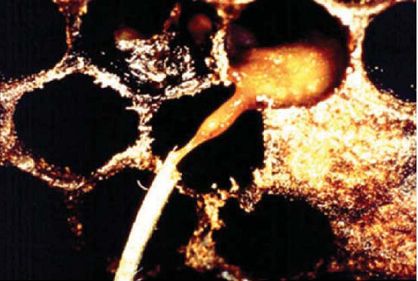
Plate 3.1: American foulbrood: the telltale rope of dead larva (Cramp, 2008)
3.5. Mites:
Parasitic mites are important enemies of honeybees found throughout India and also in the rest of Asia. Tewarson et al. (1992) provided the first insights into the life cycle of Varroa destructor on A. cerana in India. Mites that affect honeybees may be divided into four categories: a) Parasitic mites (Tracheal mite and Varroa mite) b) Predatory mites c) Phoretic mites and d) Scavenging mites (Glycyphagus sp.). Varroa mites are native parasites of Apis cerana; it causes injuries to honey bees by direct feeding on them (Plate 3.2.). The adult female pierces the bees’ soft inter-segmental membrane with its pointed chelicera and sucks the bees` haemo-lymph (‘blood’). The adult bee, however, is only damaged if the infestation is severe. Varroasis is a brood disease. If more than one parasitic female mite infests the brood cell the brood decays or deformations occur including shortened abdomen or deformed wings. Tropilaelaps clareae is a brood mite that attacks Apis dorsata colonies in India. The mite attaches to the pupae and pre-pupae stages of bees; matured female mites attach on and suck the haemo-lymph from the larvae and adults. Scavenger mites are most abundant mites in a beehive and may reach very high densities in the hive bottom. These are attached on the debris of unwanted waste material and dead bees, which are major source for food to scavenger mites.
Control measures: Synthetic chemicals (Bayvarol, Apistan, Apivar, Check Mite and Apitol) are usually reliable and effective when the mites are not chemically resistant. Use of organic products like formic acid, oxalic acid and other essential oils, is reliable to varying degrees but, for good effect, they must be employed at the right time and in the right circumstances (Cramp, 2008). As Varroa mites mostly develop in the drone cells in the colony elimination of surplus drone developing cells from the chamber, is one of the best measures to prevent mite development and spread.
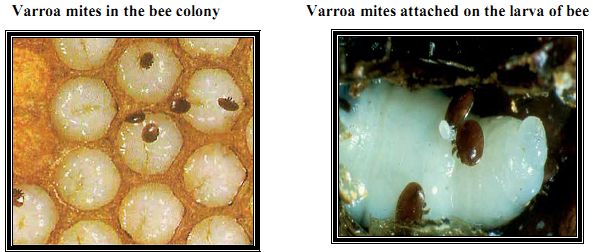
Plate 3.2: Varroa mite infestation on larvae and honeybee colony (source of photos: Clamp, 2008 and FAO United Nation Italy, 2006).
3.6. Predators
3.6.1. Insects:
There are several insect species (mainly wasp and beetle) that cause damage to bee colonies by feeding on them. In Uttara Kannada, the wasp Vespa cincta (Plate: 3.3) is major enemy of bees. The wasp feeds on entire adult bees for food and sometimes captures the prey and carries it to the wasp colony and stores it for nourishing its own young ones. During pre-monsoon season, the wasp proliferates and the young ones make new nests; the shortages of food for wasps during the rainy season make them attack bee hives for capturing their prey (Gulati and Kaushik, 2004). Several authors reported that wasps predate on honeybees causing severe damage to bee colonies and leads to loss of entire apiaries (Ghosh, 1936; Subbiah and Mahadevan, 1957; Adalakha and Sharma. 1975; Sharma and Deshraj, 1985). Philanthus ramakrishnae and Palarus orientalis are best bee hunters (Thakur, 1991). Vespa tropica is a fast flier wasp and mostly catches the forager bees (Garg and Kashyap, 1998).
Prevention of wasp predation: Destruction of wasp nests from the nearby areas, especially by burning of nest or spraying insecticide at night when all of them are in the nest, applying aerosols or fumigation by calcium cyanide etc. can reduce wasp predation (Gulati and Kaushik, 2004)
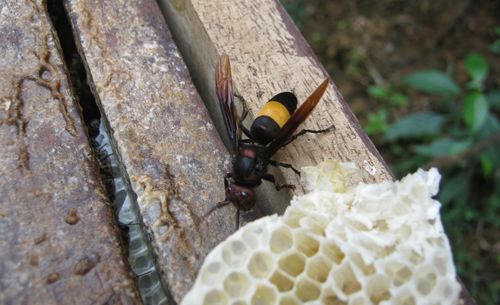
Plate 3.3: The yellow banded wasp (Vespa cincta) predates on honeybees
Wax-moth: Wax moths are found to infest hives of all species of honey bees. They do so for both food and developing their own young ones within the bee colonies, especially in Asian countries (Thakur, 1991; Gulati and Kaushik, 2004). They lay eggs in the bee hive and the larvae that emerge get covered in silken web. Such silken webs tunneling the moth larva inside are interspersed in the bee hive. The combs ultimately can be reduced to a mass of web and debris. Severe infestation leads to suspension in brood rearing, foraging activity and ultimately desertion of bee colony from the nest (Plate: 3.4).
Control measures: It is difficult to control max moth attack on beehives. The best defense, however, is to maintain strong, healthy colonies, compact and good hive and reduction of entrance size, which are effective control on wax moth. Some authors recommended eradication of wax moth from hive by treating with hot water, and through chemical treatments (Gulati and Kaushik, 2004). Chemical treatment should be avoided as much as possible so that the organic nature of the health food like honey is maintained.
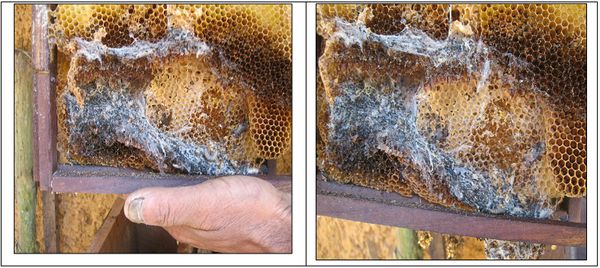
Plate 3.4: Wax moth damages on bee hive
Ants: Ants are cosmopolitan predators of honeybees in tropical and sub-tropical regions. Some species (weaver ant, the black ant fire ants and Formica spp) enter bee colonies in search for food, mainly honey, or for establishing nesting sites. Damages to Apis cerana colonies have been noticed (Thakur, 1991; Gulati and Kaushik, 2004). Even though ants are not serious pests rarely disturbing the bees, these can be of nuisance to the beekeeper.
Prevention and control: Honeybees are in the habit of fanning their wings to keep optimum temperature within the bee hive. This fanning by thousands of bees create strong currents within the bee box that does not allow free movement of ants. The bees also have the practice of pasting cracks and crevices in the hives with propolis, a resinous substance of plant origin. The ants can still congregate in places where the fanning effect does not reach. Protection of bee hives from ants is very necessary on the part of the bee keepers. Placing legs of the bee boxes dipped in earthen vessels containing water prevents ants from access to the colony. Few authors stated that applying spent engine oil and grease on the bottom and stands of the bee box acts as a repellent for ants (Thakur, 1991 and Gulati and Kaushik, 2004).
3.6.2. Birds
Cobb (1979) reported 47 species of insectivorous birds under the 24 families, out of 74 insectivorous families of birds in India, which feed primarily on honeybees and bee-wax. The degree of damage to commercial apiaries caused by predatory birds depends largely on the number of the predators and the intensity of the attack, the mere presence of a few predators in apiaries engaged in queen rearing can inflict serious losses. In Uttara Kannada, some places are seriously affected due to bird predation (for e.g. Harehulekal, Kakkalli and Vannalli of Sirsi taluk). The main bird predators here affecting apiaries are (Plate: 3.5) small green bee-eaters (Merops orientalis), drongos (Dicurus spp.), swifts (Cypselus spp., Apus spp.), shrikes (Lanius spp.), and woodpeckers (Picus spp.).
Prevention: Scaring away the birds is most effective in checking their visits' to beehives. High pitch sounds with different notes, beating the drums and empty tins etc. have been recommended (Gulati and Kaushik, 2004).
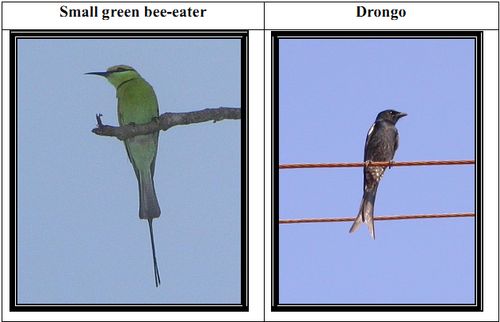
Plate 3.5: Some honeybee predating birds